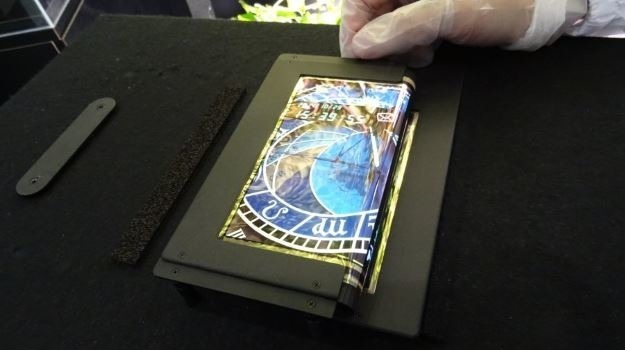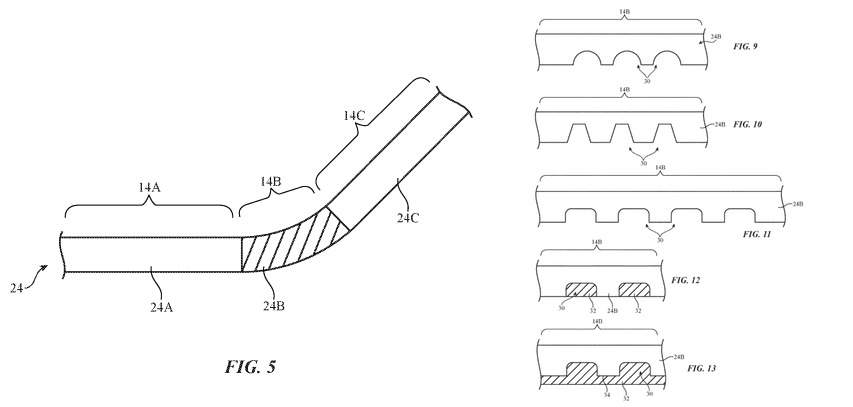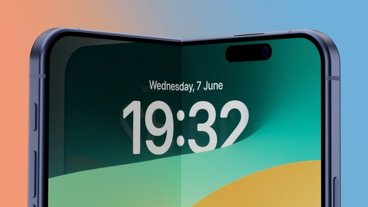Apple is still examining the possibility of creating a mobile device with a large screen that can be compacted into a smaller size, using a flexible section in the middle of the device to allow the screen to bend enough for it to fold without breaking.
Granted by the U.S. Patent and Trademark Office on Tuesday, the patent for "Electronic devices with flexible displays" details how a folding mobile device could be created. While foldable, the device could feasibly have a screen taking up an entire side of the device, similar to a smartphone or tablet, but with one cohesive display rather than using two or more with a noticeable line in the middle.
According to the patent, the concept relies on using multiple flexible elements in the middle of the device. In the process of flexing the device for the fold, the patent notes there will be a compression of material on the inside of the fold, and a thinning of material on the outside, with the former likely to cause an issue for the display layer.
To counter this problem the patent suggests the use of recesses in the material protecting the display layer in the middle section of the device, reducing the congregating mass and the amount of stress on layers closer to the inside of the fold.
It is said that there could be solid inflexible glass covers for sections of the display that are not affected by the fold, with a flexible cover spanning the gap between the two solid sections. In one implementation, the glass layer can even be bent, supported by a polymer layer for the bend itself, with grooves added to the glass in parallel to the bent section.
Aside from the display, the rest of the hypothetical device would also require flexible materials to cover the outside of the fold, and can possibly even include a hinge in the middle to help keep the bend occurring at one point in the flexible section.
Apple initially filed the application on June 8, 2016, and credits Jiang Ai, Erik A. Uttermann, and Soyoung Kim as inventors.
The latest patent is one in a string of similar applications Apple has submitted to the USPTO over the years.
One filing discovered in October 2017 surfaced at the same time as a rumor claiming Apple is working with LG to produce an OLED iPhone by 2020. Merrill Lynch analyst Wamsi Mohan wrote a note to investors in March suggesting a similar launch timeframe for the device, adding that the device could also "double up as a tablet," giving the utility of a larger screen but with the portability of a smartphone.
Another patent granted in November 2016 suggested the use of a hinge and a metal-backed flexible OLED panel to create a foldable smartphone, one that could clip onto clothing for storage when not in use.
Apple has also invested heavily in a new display technology that could help bring such hardware to fruition. MicroLED is effectively a display panel made up of tiny LEDs on a sheet, which aside from potentially offering power savings and a reduced screen thickness, could be used to produce a flexible screen required for a foldable device.
While Apple regularly files patent applications with the USPTO, the publication of an application or the granting of a patent is not necessarily a sign that Apple is actively working on using the technology with its products, nor is it a guarantee it will be usable by consumers in a future release. Though it is plausible to be used in a foldable smartphone, a concept also being examined by Apple's competitors, it is equally likely elements of this patent could be used in other hardware and not a mobile device.
 Malcolm Owen
Malcolm Owen








-m.jpg)






 Christine McKee
Christine McKee
 Marko Zivkovic
Marko Zivkovic
 Mike Wuerthele
Mike Wuerthele

 Amber Neely
Amber Neely
 Sponsored Content
Sponsored Content
 Wesley Hilliard
Wesley Hilliard









10 Comments
Ah. So Apple is behind on screen tech but "considering" leadership in foldables.
Let's make an educated guess what that may result in.
I see little benefit and many potential drawbacks to flexible displays that can be bent by the user. Flex harnesses are in wide use in multi-circuit card housings and laptops but quality and robustness in moving hardware are not their strengths.
I could see a use where a flexible display is wrapped around the sides/edges of an iPhone to indicate certain functionality in ON/OFF/STANDBY mode. It could be quite colorful and enhance the user experience.
But flex displays that are folded like a book or newspaper, meh.
This is going to be a tough one to crack (no pun). A section of the screen that is folded and unfolded is going to be under a lot of stress, rather a lot of the time. It's like trying to make a piece of paper that doesn't crease when you fold it in half. Only that stress has to be borne by the glass on the surface, the display substrate (LCD, OLED, whatever), and the controlling circuitry. So take 3 pieces of medium cardboard stacked together, and fold them so that they close like a book, then open them again. That's what we're dealing with. The materials used need to take that kind of stress, without showing signs of wear for a reasonable amount of time, on a phone usually at least 2 years.
It will be really interesting to see what solutions (if any) they come up with. A slight discontinuity in the screen may be forgivable in some circumstances, and being Apple, they could well turn a physical limitation into a selling point. Or this all might just be a matter of locking down ideas to prevent other people coming up with them.
Personally, I see a lot more possibility in something that can be rolled, rather than folded. The stresses are lower, and it meets some of the requirements. then again a cylinder isn't necessarily as easy as a flat folded device to carry about.
If anybody can do it, Apple can.
Form factor is more suitable to iPad IMO, the modern organizer book.